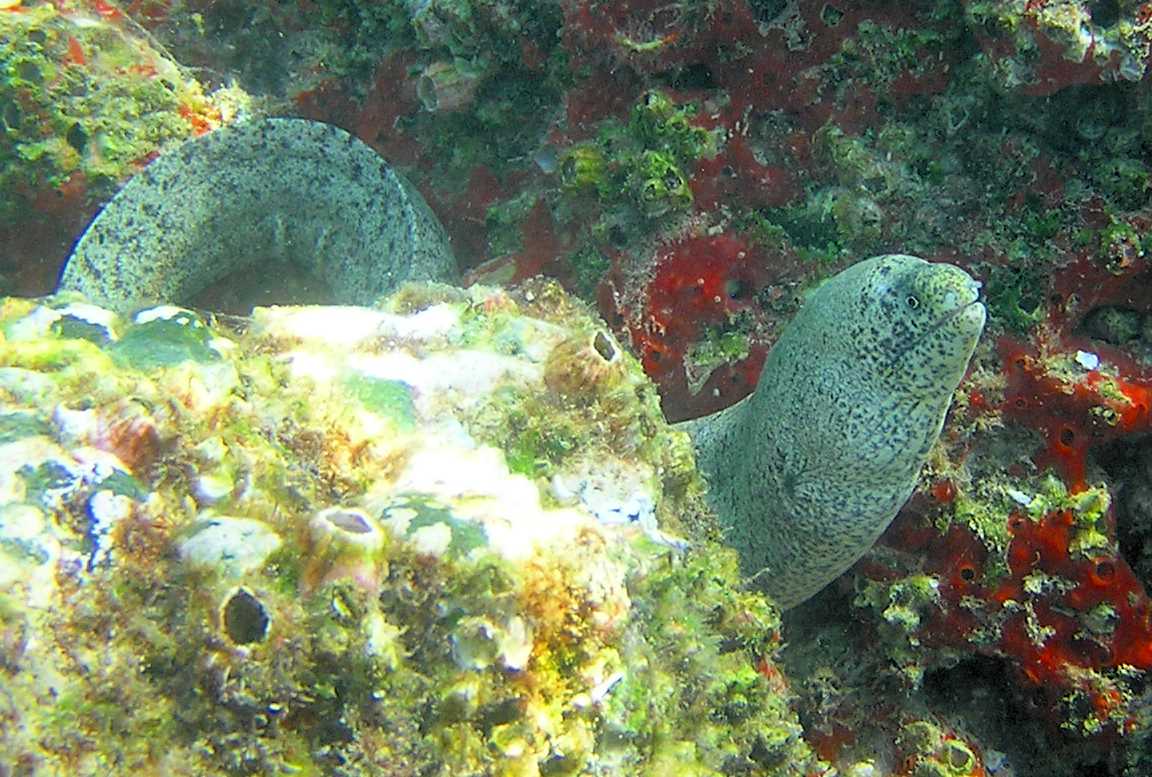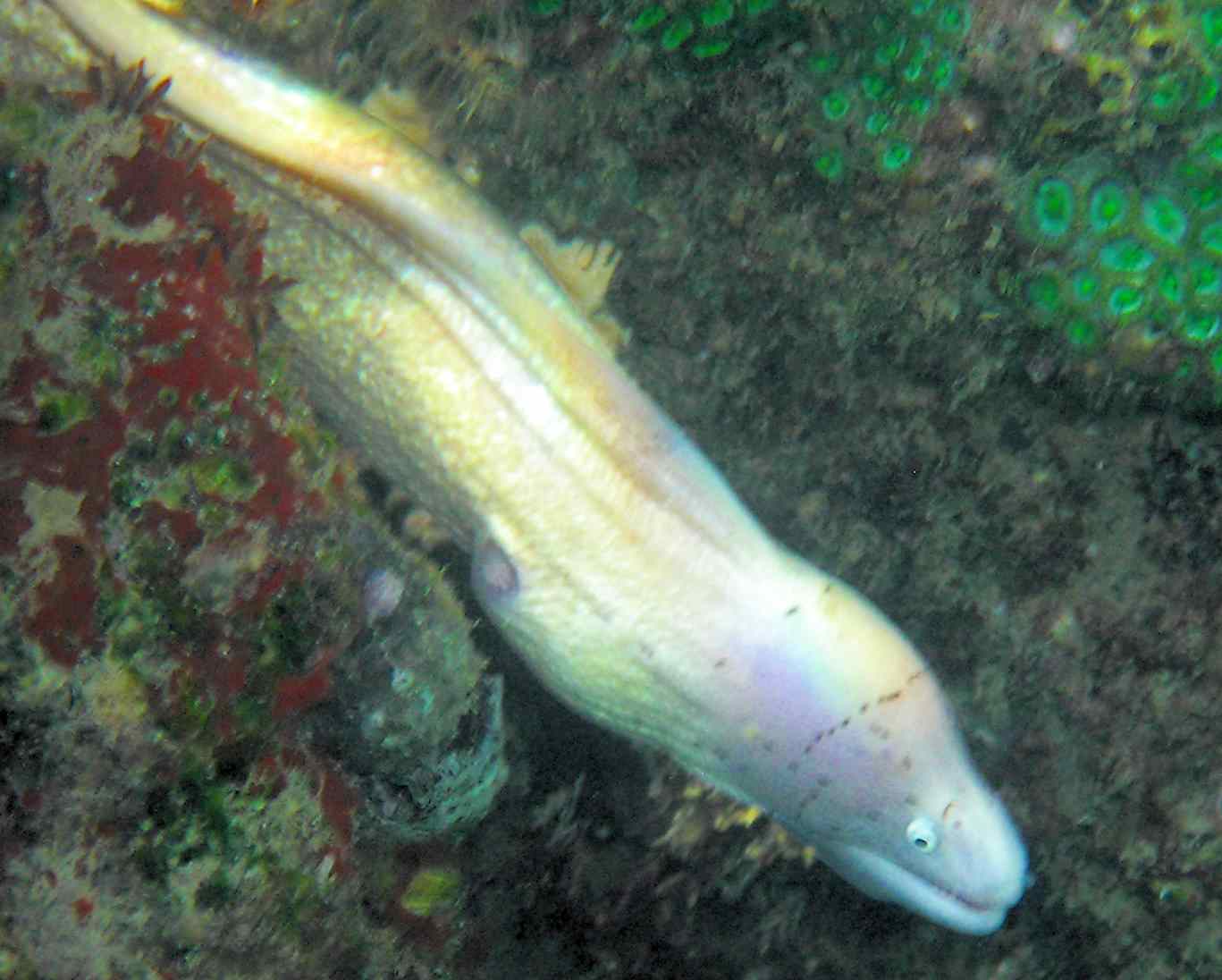zurück Übersicht
Oman Muräne Muränen Weiße Muräne
zurück
vor
 murena
murena


Muränen,
or moray eels, are a fascinating
group of marine eels belonging to the family
Muraenidae. They are known for
their elongated, snake-like bodies and are found in warm, tropical, and
subtropical waters around the world. Moray eels are predatory creatures that
often live in crevices or holes in the reef, making them an interesting but
elusive species to encounter.
Key Features of
Moray Eels (Muränen):
1.
Physical Characteristics
-
Body Shape: Moray eels have long, cylindrical bodies that can range
from a few centimeters to over 3
meters (10 feet) in length, depending on the species. Their bodies
are often smooth and slimy, helping them navigate through tight crevices in
coral reefs and rocky environments.
-
Coloration: Moray eels come
in a variety of colors, including
green, brown,
yellow, and
gray, often with
distinctive patterns like spots or bands. Some species have very striking
colors and patterns, making them quite visually appealing.
-
Teeth: Moray eels are
known for their sharp teeth
that are designed for grabbing and holding onto prey. Their teeth are
backward-facing, ensuring that the prey cannot easily escape once caught.
2.
Habitat
-
Reef Dwellers: Moray eels
are commonly found in coral reefs,
rocky shorelines, and
sand flats at depths of
up to several hundred meters. They are most often found hiding in crevices,
caves, or under ledges, where they stay protected during the day and emerge
at night to hunt.
-
Tropical and Subtropical Waters:
They are typically found in warm
tropical and subtropical
seas around the world, especially in the
Indo-Pacific, the
Caribbean, and parts of
the Atlantic Ocean.
3.
Diet and Hunting
-
Carnivores: Moray eels
are carnivorous
predators, feeding on a variety of prey, including
fish,
crustaceans, and
cephalopods (like squid).
They are particularly skilled at hunting small fish and invertebrates that
live within crevices and cracks in the reef.
-
Hunting Technique: Moray
eels are ambush predators, using their excellent sense of smell and sharp
teeth to capture their prey. They are also known for their
two sets of jaws. In
addition to their regular jaws, they have a second set of jaws called
pharyngeal jaws that help
pull prey further into their throats.
-
Mouth Movements: Moray
eels are often seen with their mouths slightly open. This is not a sign of
aggression but rather a part of their breathing mechanism, as they use their
jaws to force water through their gills.
4.
Behavior
-
Nocturnal: Most species
of moray eels are nocturnal,
meaning they are most active at night when they leave their hiding places to
hunt. During the day, they typically remain hidden in caves or crevices,
resting.
-
Territorial: Moray eels
can be quite territorial, often defending their chosen crevice or cave
against other predators or moray eels. They are known to be aggressive if
they feel threatened, but generally, they are not dangerous unless provoked.
-
Social Behavior: While
moray eels are solitary by nature, some species have been observed in pairs
or groups, especially during mating seasons. In certain cases, they may
share hiding spots with other species of fish, forming a mutual
relationship.
5.
Reproduction
-
Spawning: Moray eels
generally do not have elaborate courtship rituals. Instead, they release
eggs and sperm into the water column, where fertilization occurs externally.
The fertilized eggs hatch into
larvae, which float freely in the ocean before settling into the
reef environment once they mature.
-
Life Cycle: The
larvae of moray eels can
drift for long distances, and some species are believed to migrate over
great distances before settling into coastal reefs as adults. The process
can take several months, and the larvae undergo dramatic changes before
becoming the adult eels we recognize.
6.
Venom and Defense
-
Not Venomous: While many
people associate eels with danger,
moray eels are not venomous. However, they do have
sharp teeth and can
deliver a painful bite if threatened. The bite, though painful, is rarely
fatal, and moray eels typically bite in self-defense rather than to attack
humans.
-
Defensive Behavior: They
are more likely to hide from humans or other threats. If a moray feels
cornered or threatened, it may bite as a form of defense.
7.
Ecological Role
-
Predators: Moray eels
play an essential role in maintaining the balance of the reef ecosystem by
controlling populations of smaller fish and invertebrates.
-
Cleaner Fish Symbiosis:
In some cases, moray eels have mutualistic relationships with
cleaner fish, like
cleaner wrasses, that remove parasites from their skin. This mutual benefit
helps the eel stay free of harmful parasites while providing the cleaner
fish with a meal.
8.
Interesting Facts
-
Ancient Creatures: Moray
eels are an ancient group, having existed for millions of years. Fossils of
moray eel species date back to the
Eocene period (about 50 million years ago).
-
Unusual Breathing: Moray
eels have a unique way of breathing. In addition to using their gills, they
also have an open mouth
to allow water to flow over their gills, ensuring constant oxygen intake
while they are hiding or resting.
9.
Popular Species
-
Giant Moray (Gymnothorax
javanicus): One of the most famous species, the giant moray eel,
can grow up to 2.5 meters (8 feet)
in length. It is found throughout the Indo-Pacific region.
-
Yellow-edged Moray (Gymnothorax
flavimarginatus): Known for its vibrant coloration, this species is
commonly found in the Indo-Pacific and is one of the more colorful moray
eels.
-
Snowflake Moray (Echidna nebulosa):
Recognized for its distinctive white, speckled pattern, the snowflake moray
is a popular species among aquarium enthusiasts.
Conclusion:
Moray eels (Muränen) are
fascinating creatures of the ocean, known for their unique appearance,
impressive hunting techniques, and sometimes intimidating behavior. While they
are not typically dangerous to humans, they play a crucial role in marine
ecosystems as predators. Whether you encounter them on a dive or observe them in
an aquarium, these eels offer a glimpse into the mysteries of the deep sea and
the adaptability of marine life.
 04.10.25 Copyright Dirk
Rauschenbach Koelnerstrasse 293 51702 Bergneustadt
Datenschutzerklaerung 02261 9788972 Mail ccooly(
at) web.de
04.10.25 Copyright Dirk
Rauschenbach Koelnerstrasse 293 51702 Bergneustadt
Datenschutzerklaerung 02261 9788972 Mail ccooly(
at) web.de
 Safaris
Bergsteigen
Wandern
Inselwandern Weltweit
Safaris
Bergsteigen
Wandern
Inselwandern Weltweit
 Europa
Inselwandern
Europa
Inselwandern
 Städtewandern
Städtewandern
 Paintings
Paintings  Dirk Rauschenbach
Dirk Rauschenbach
 Safaris
Bergsteigen
Wandern
Inselwandern Weltweit
Safaris
Bergsteigen
Wandern
Inselwandern Weltweit
 Europa
Inselwandern
Europa
Inselwandern
 Städtewandern
Städtewandern
 Paintings
Paintings  Dirk Rauschenbach
Dirk Rauschenbach
murena
![]() 04.10.25 Copyright Dirk
Rauschenbach Koelnerstrasse 293 51702 Bergneustadt
Datenschutzerklaerung 02261 9788972 Mail ccooly(
at) web.de
04.10.25 Copyright Dirk
Rauschenbach Koelnerstrasse 293 51702 Bergneustadt
Datenschutzerklaerung 02261 9788972 Mail ccooly(
at) web.de